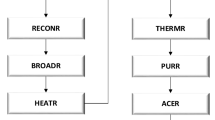Abstract
Multi-group cross section library is the basic condition for lattice calculation, which provides the necessary nuclear data parameters. The multi-functional lattice code SONG (Si et al. in Nucl Power Eng 35:111–115, 2014. doi:10.13832/j.jnpe.2014.S2.0112; Chen et al. in Nucl Power Eng 35:127–130, 2014. doi:10.13832/j.jnpe.2014.S2.0127) is developed to adapt to the research demands of different types of new reactors, especially the fourth generation (GEN-IV) reactors (Cerullo and Lomonaco in Nucl Fuel Cycle Sci Eng, 2012. doi:10.1533/9780857096388.3.333; Giorgio et al. in Energy Policy 61:1503–1520, 2013. doi:10.1016/j.enpol.2013.06.101). The corresponding multi-group cross section library of SONG (SONGLIB) is well designed with much effort considering the next generation reactors’ new feature in material, spectrum, burnup depth, etc. Therefore, the burnup chain (Maria and Jaakko in Nucl Sci Eng 164:140–150, 2010. doi:10.13182/NSE09-14), energy group structure (Tholakele et al. in Ann Nucl Energy 80:279–292, 2015. doi:10.1016/j.anucene.2015.01.038), and reaction path should be specially considered. The library SONGLIB is processed with the Evaluated Nuclear Data File (ENDF), nuclide data auxiliary processing code NJOYBAT (Si et al. 2014), and library management code MANLIB (Si et al. 2014). A series of verification work of SONGLIB is then carried out, and the calculated results are satisfied.







Similar content being viewed by others
References
Y.A. Yousry, Multiprocessing for neutron diffusion and deterministic transport methods. Prog. Nucl. Energy 31, 317–368 (1997). doi:10.1016/S0149-1970(96)00015-7
C. Chen, J. Zou, J. Zheng et al., Development and testing of the code for automatic generating of multi-temperature continuous-energy neutron cross section libraries. Nucl. Sci. Tech. 25, 050602 (2014). doi:10.13538/j.1001-8042/nst.25.050602
A.D. Stephen, K.F. Stanley, Monte Carlo modeling of neutron transport. in A Monte Carlo Primer ed. by A.D. Stephen (Springer, New York, 2002), pp. 57–88. doi: 10.1007/978-1-4419-8491-3_3
S.Y. Si, Q.C. Chen, J.K. Zhao et al., SONG-description of multi-functional lattice code. Nucl. Power Eng. 35, 111–115 (2014). doi:10.13832/j.jnpe.2014.S2.0112. (in Chinese)
Q.C. Chen, S.Y. Si, J.K. Zhao et al., SONG-development of transport modules. Nucl. Power Eng. 35, 127–130 (2014). doi:10.13832/j.jnpe.2014.S2.0127. (in Chinese)
N. Cerullo, G. Lomonaco, 13-Generation IV reactor designs, operation and fuel cycle. Nucl. Fuel Cycle Sci. Eng. (2012). doi:10.1533/9780857096388.3.333
L. Giorgio, M. Mauro, T. Nicola, Generation IV nuclear reactors: current status and future prospects. Energy Policy 61, 1503–1520 (2013). doi:10.1016/j.enpol.2013.06.101
L. Michel, G. Otto, Perspectives of the thorium fuel cycle. Nucl. Eng. Des. 180, 133–146 (1998). doi:10.1016/S0029-5493(97)00296-3
H.Q. Zhang, J. Lin, C.Q. Cao et al., Simulation study on 232Th-233U conversion in thermal reactors. Nucl. Tech. 38, 050601 (2015). doi:10.11889/j.0253-3219.2015.hjs.38.050601. (in Chinese)
G.A. Ye, T.H. Yan, 20-development of closed nuclear fuel cycles in China. Reprocess. Recycl. Spent Nucl. Fuel (2015). doi:10.1016/B978-1-78242-212-9.00020-4
P. Maria, L. Jaakko, Computing the matrix exponential in burnup calculations. Nucl. Sci. Eng. 164, 140–150 (2010). doi:10.13182/NSE09-14
P.N. Tholakele, N.I. Kostadin, L. Samuel, Examination and refinement of fine energy group structure for high temperature reactor analysis. Ann. Nucl. Energy 80, 279–292 (2015). doi:10.1016/j.anucene.2015.01.038
C.L. Wang, Y. Xiao, J.J. Zhou et al., CFD analysis of a fluoride salt cooled pebble-bed test reactor. Nucl. Sci. Eng. 178, 86–102 (2014). doi:10.13182/NSE13-60
D.L. Zhang, A. Rineiski, C.L. Wang et al., Development of a kinetic model for safety studies of liquid-fuel reactors. Prog. Nucl. Energy 81, 104–112 (2015). doi:10.1016/j.pnucene.2015.01.011
C.L. Wang, Z.P. Guo, D.L. Zhang et al., Transient behavior of the sodium-potassium alloy heat pipe in passive residual heat removal system of molten salt reactor. Prog. Nucl. Energy 68, 142–152 (2013). doi:10.1016/j.pnucene.2013.07.001
M.L. Xie, Y.Q. Chen, L. Yu et al., Optimization analysis of the production process based on WIMS format multi-group nuclear data. Nucl. Tech. 38, 110502 (2015). doi:10.11889/j.0253-3219.2015.hjs.38.110502. (in Chinese)
J.J. Hou, S.Q. Wang, Y. Cai et al., Conceptual core design of small traveling wave reactors based on coupled code of MCNP-ORIGEN. Nucl. Tech. 38, 080603 (2015). doi:10.11889/j.0253-3219.2015.hjs.38.080603. (in Chinese)
K.S. Kim, G.H. Ser, A new procedure to generate resonance integral table with an explicit resonance interference for transport lattice codes. Ann. Nucl. Energy 38, 118–127 (2011). doi:10.1016/j.anucene.2010.08.005
H. Roushdy, Derivation of modified approximate analytical formulae for calculating the direct and adjoint flux weighted resonance integrals using a variable neutron spectrum. Ann. Nucl. Energy 27, 133–141 (2000). doi:10.1016/S0306-4549(99)00041-9
X.M. Zhou, X.H. Wang, Study on multigroup nuclear cross section library for TMSR-SF at high temperature. Nucl. Tech. 37, 120602 (2014). doi:10.11889/j.0253-3219.2014.hjs.37.120602
M.S. Cheng, Z.M. Dai, Development of a three dimension multi-physics code for molten salt fast reactor. Nucl. Sci. Tech. 25, 010601 (2014). doi:10.13538/j.1001-8042/nst.25.010601
M.B. Chadwick, P. Obložinský, M. Herman, ENDF/B-VII.0: next generation evaluated nuclear data library for nuclear science and technology. Nucl. Data Sheets 107, 2931–3060 (2006). doi:10.1016/j.nds.2006.11.001




